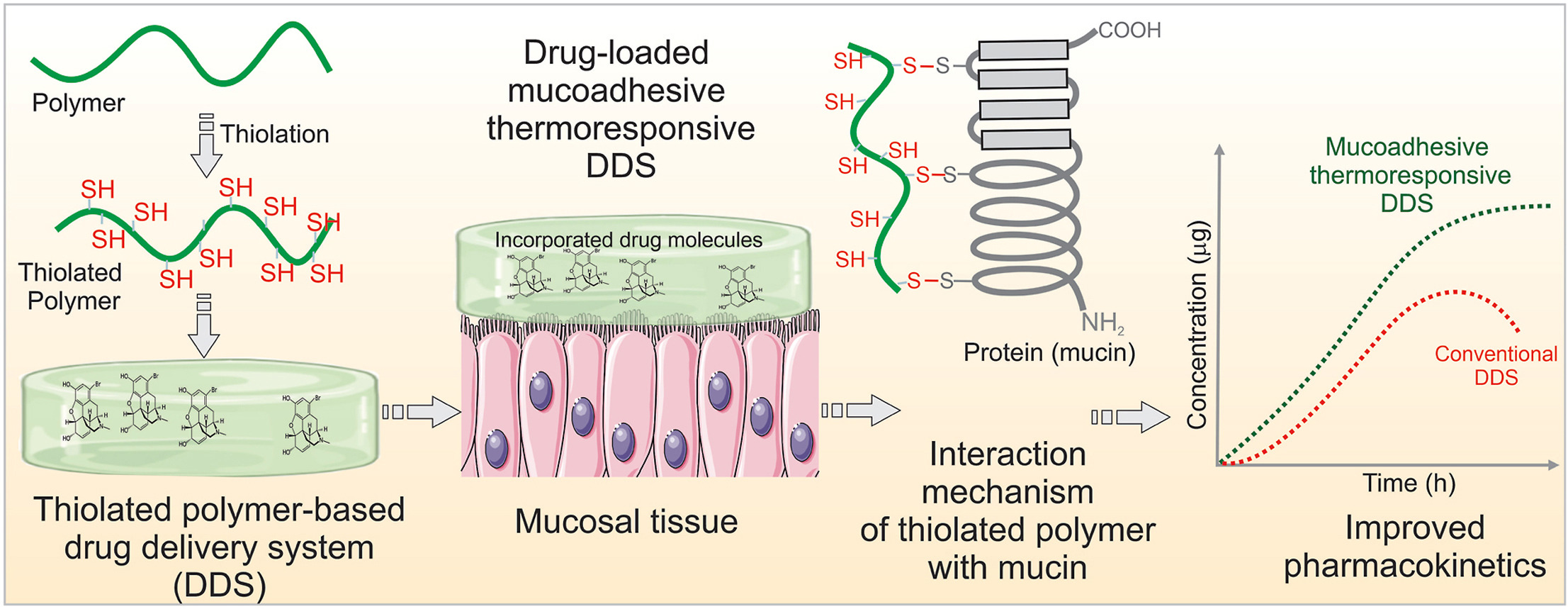Thiolated polymers: An overview of mucoadhesive properties and their potential in drug delivery via mucosal tissues

Abstract
Thiolated polymers, or thiomers, are a class of polymers that exhibit unique mucoadhesive properties, allowing them to form strong covalent bonds with cysteine-rich subdomains of mucus glycoproteins. This property makes them ideal for developing drug delivery systems (DDSs) for various dry mucosal surface diseases. Compared to their non-thiolated counterparts, thiomers offer higher adhesion and retention time, leading to increased bioavailability and reduced patient noncompliance. They can also inhibit certain enzymes, increase permeability, and shield protein and peptide drugs from digestive enzymes. Thiomers have been investigated for use in various routes of administration, and different types of polymers have been thiolated using different thiolation moieties. Thiolated polymers have great application potential, including mucoadhesive and controlled drug release, and tissue engineering. This review explores the impacts of thiolation and the function of thiomers in different administration routes, highlighting their potential to empower drug delivery via mucosal tissues for improved therapeutic outcomes.
Introduction
Thiolated polymers (thiomers) were introduced in the 1990s with unique mucoadhesive characteristics. Their particular mucoadhesive property results from their ability to form strong covalent bonds with cysteine-rich subdomains of mucus glycoproteins through a disulfide-thiol exchange process [1]. Such interaction of thiolated polymers results in marked mucoadhesiveness with mucosal tissues, which is an important feature in terms of the development of DDSs used in the treatment of various diseases with dry mucosal surfaces such as dry eye, and dry mouth. Compared to their non-thiolated counterparts, thiomer polymers can significantly enhance the localized delivery of drugs via multiple routes of administration mainly due to the higher adhesion and retention time. Such a feature results in an overall increase in bioavailability, which decreases dose frequency and patient noncompliance [[2], [3], [4], [5]]. It has also been demonstrated that some thiomers inhibit certain enzymes, increase permeability, and inhibit the efflux pump. Additionally, they could shield protein and peptide drugs from digestive enzymes [6]. However, it should be noted that thiomers could be destabilized by thiol oxidation at pH 5 or below in solutions and gels, unless the environment is inert. This could reduce the mucoadhesion and effectiveness of the thiomers. To circumvent this potential oxidation obstacle, thiol groups are pre-activated to improve their stability and preserve their mucoadhesive properties [7].
The impact of thiomers on the bioavailability of dosage forms has been investigated for the buccal, intranasal, ocular, oral, vaginal, transdermal, and parenteral [8]. Some biopolymers that have been thiolated include gelatin, hyaluronic acid, chitosan, alginate, pectin, carrageenan, karaya gum, xanthan gum, gellan gum, and moringa gum. Some thiolation moieties used include thioglycolic acid, thiourea, 4-aminothiophenol, l-cysteine, and Traut’s reagent (2-iminothiolane), among others [9]. This review seeks to outline the impact of thiomers in terms of the development and application of different dosage forms for various routes of drug administration.
Read more here
Kwadwo Mfoafo, Rahul Mittal, Adrien Eshraghi, Yadollah Omidi, Hossein Omidian, Thiolated polymers: An overview of mucoadhesive properties and their potential in drug delivery via mucosal tissues, Journal of Drug Delivery Science and Technology, Volume 85, 2023, 104596, ISSN 1773-2247, https://doi.org/10.1016/j.jddst.2023.104596.
Read more on Chitosan as a pharmaceutical excipient here:


